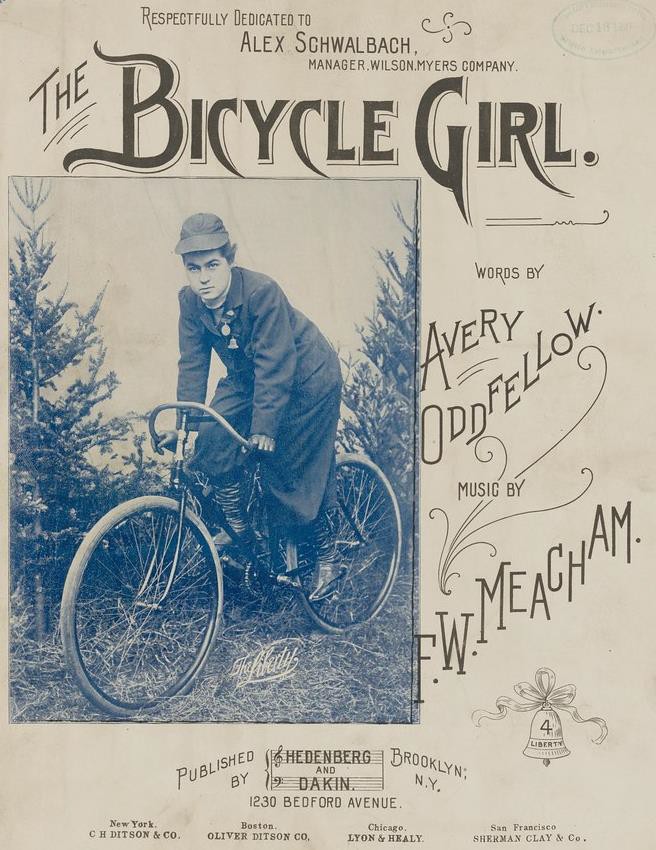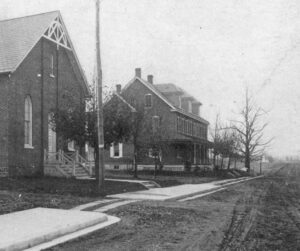Here’s a riddle for you: What can make you tremble violently, give you a wild impulse to throw yourself in front of a moving trolley, give the feeling of a menacing presence behind you, or have the landscape curl up in front of you?
Answer: Riding a bicycle, of course!
Modern readers may not comprehend the ways our so-familiar bicycle changed the world. But the template of what we know as the bicycle was in place by the 1890s, creating a craze for the contraption in Europe and the United States.
Souderton and Telford were swept up in this craze as early as 1891. For the first time since the advent of the railroad through Franconia in 1857, this new mode of transportation was a game-changer. Before the bicycle you walked, caught the train, hitched up your horse or rented one from the five local livery stables.
After the bicycle, some owners gave up horses entirely, relying solely on the “wheel.” If you remember a childhood in which your bicycle gave you freedom to explore, you can imagine how children in the 1890s finally had a recreational outlet that didn’t necessarily include creating mischief. Or maybe now they just had a faster get-away.
Those mischievous children can thank a German baron who, in the early 1800s, invented the precursor to the modern bicycle. It had two wheels connected by a bar. The “rider” walked or ran to build momentum, repeating the exercise as the motion slowed.
This was followed by a French invention that attached pedals to a much larger front wheel. It wasn’t the most comfortable ride — the bike was called the “boneshaker” — nor the safest.
It was the advent of the “safety bicycle,” built by an Englishman in 1865, that sparked a golden age. The inflatable wheels on this model were the same size with a chain that connected the pedals to the rear wheel and a steerable front wheel.
Bicycle factories in this area were numerous by 1895, with close to 130 large manufacturers throughout the United States, along with many smaller makers. Relay of Reading (Pa.) and Falcon of Toledo (Ohio) were two popular brands sold in Souderton.
While the booming popularity of the bicycle offered a new sense of personal freedom — “scarcely inferior to what wings would give” as the New York Times reported in 1896 — it also brought out less pleasant aspects.
Major newspapers reported on the dangers of bicycling. An eminent expert told a London newspaper in 1890 that boys and girls should never ride a bicycle because it “molds the bodily framework” into what he called the “ungraceful” cyclist’s figure.
Hysterics on wheels and hallucinations became a recognized psychological disorder. By 1893, however, there was agreement that even for girls and women, riding a bicycle was a healthy activity. One expert told a New York Times reporter that it had been shown to be “far more potent in stimulating a healthy cerebral activity … than any medicinal remedy.”
Locally, the growth of bike riding and the subsequent accidents brought one insurance salesman — well dressed and glib-of-tongue — onto the scene. For one dollar a year — yes, my friend, only one dollar — you could insure yourself if you took a header over your wheel. Fifty-three Schwenksvillers were insured before that scoundrel melted out of sight.
Every bicycle owner, wanting to keep up with the times, started painting their two-wheeled conveyance bright and fancy colors with ornamental gold stripes. Those who were musically inclined may have attached rubber bands of various sizes from the horizontal bar to the tube that extends from the crank bearing to the saddle, creating an aeolian harp melody when in motion.
One church outside Philadelphia even accommodated bicycle riders by offering a shed able to house as many as 40 bikes. The owners could worship knowing the shed would be guarded, and possibly repairs even conducted.
The use of bicycles by girls and women stirred up quite a bit of anxiety everywhere. In the 1890s, the growing women’s rights movement used the female bicycle rider to embody the spirit of change and progress it hoped to inspire, according to the National Women’s History Museum. The “New Woman” of the 1890s was young, college educated, active in sports, interested in a career, and wanted a marriage based on equality. And she was also almost always depicted on a bicycle.
But now a vexing concern grew over the female cycling costume. In the days of long, heavy skirts and bustles, how could a woman ride a bicycle and still exhibit modesty and femininity? The problem was finally resolved by a contest held in Cincinnati. The winning costume was a divided dress skirt held by suspenders, a silk blouse held at the waist by a rubber band, a jacket made of the same cloth or flannel as the skirt, in shades of black, gray, navy or brown, a Windsor tie at the neck, a yachting cap, gauntlet gloves and for underwear, a union suit.

This song, published in 1895, is a commentary on the outfit worn by the bicycle girl. As the lyrics say, “she’s fast on the wheel and in matters of dress.
Source: Library of Congress, Music Division
Riding your “wheel” in the countryside of Souderton and Telford was not for the faint of heart.
One of the area’s fastest racing bicyclists, David H. Yerger of Telford, discovered this when cycling on County Line Road. He met with a young steer grazing by the side of the road who took an instant dislike to the man on the machine, delivering a blow to Yerger’s left leg and sending him into the ditch, injuring both the cyclist and beast.
Cyclists also learned to watch carefully for snakes sunning on the road, which could quickly get wrapped around the wheel and thrown upward onto the rider.
Bicycle clubs sprang up across the country. The Ariel Wheelmen organized in Souderton in May 1895. Members David H. Yerger and Edwin S. Kratz of Souderton competed in races organized by the Olympian Cycle Club of Sellersville, which offered prizes ranging from bicycle gear such as shoes, lamps, bells, and cyclometers, to boxes of cigars, large cakes, a pitchfork, and teacups — possibly not the most sought-after prize. A booby prize was once a small yellow dog, won by a child competing against the adults. The child likely was happy with the outcome; the same probably could not be said of his mother.
Yerger and Kratz were often the winners, riding their “Falcon” or “Relay” bicycles happily sold to them by jeweler C. S. Hunsberger of Souderton, located at what is today 212 N. Main St.

An advertisement for Souderton
bicycle dealer/jeweler C.S. Hunsberger.
In September 1897, large crowds gathered at Menlo Park track in Perkasie to learn once and for all who was the fastest cyclist. The five-mile race ended with David Yerger coming in first with a time of 15.45 minutes followed by Dalton Pfleiger of Perkasie at 15.46. Edwin Kratz did not compete that day.
What is particularly fascinating was the tendency for men from Telford and Souderton to “have a spin on the wheel” and ride to places like Harrisburg, Allentown, Reading, or Philadelphia. In the 1890s, the maintained roads, which were few and far between, were dirt, ashes, and stone. Dusty, muddy, slippery, or rutted was what you could expect.
The best were turnpikes, which begged the question: Should bicycle riders be charged tolls? When the edict came down in 1895 that the wheelmen needed to pay one cent per mile, the lament was that no one would be leaving the borough of Souderton, only riding up and down Main Street within the borough limits between Summit and West Broad Street. At least the hill was challenging.

Hamlin Avenue outside the Evangelical Church,
Telford. The muddy, rutted surface of the
“avenue” was typical of the late 19th century.
By 1898, the toll laws were changing in favor of the bicycle riders; after all you didn’t charge a woman pushing a buggy or a man with a wheelbarrow, and the bill proposing a bicycle tax was quickly defeated. Grumbling horse and carriage drivers often were reminded that all bicycles and tricycles were “entitled to the same rights and subject to the same restrictions … as persons using carriages drawn by horses” when using the highways. Often these grumblers enjoyed edging riders into ditches, bringing about talk of the need for bicycle lanes.
By 1899 the intense interest in the bicycle had waned. Trolley tracks were being laid throughout Souderton, eventually connecting to surrounding towns and giving people of all ages and physical ability much wider access to places where travel had once been more difficult. Eventually, a combination of rail and trolley could take you on adventures to parts of the country you had only ever dreamed about.
Bicyclists of the 1890s did more for the future of our area than they could have imagined. The organized groups such as the Ariel Wheelmen demanded better roads so that by 1903, when the first locomobiles — as the earliest autos were called — were purchased by Soudertonians, roads were well on the way to becoming safer, better constructed, and easier to navigate. All thanks to the perseverance of the bicycle rider.
***
The Souderton-Telford Historical Society seeks to preserve and share the history of our towns, businesses, and residents. Follow us on Facebook (@SoudertonTelfordHistory) and enjoy posts about local history. Do you have old photographs we can scan for our collection? Or a story to share about growing up in the Souderton-Telford area? We would like to hear from you! Email newsletter@soudertontelfordhistory.org.
The Souderton-Telford Historical Society is a 501(c)(3) non-profit. Your contribution helps to collect, preserve, and share the history of our towns. Tax-deductible donations may be mailed to:
Souderton-Telford Historical Society
127 E. Broad St.
Souderton PA 18964
Or use the DONATE button on our Facebook page.
